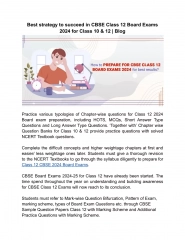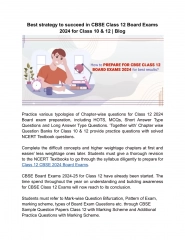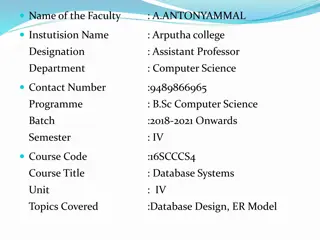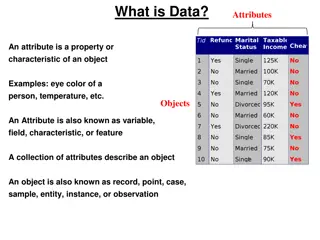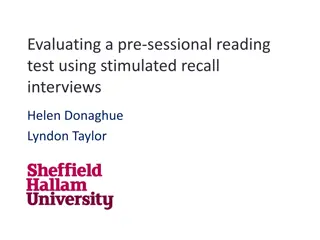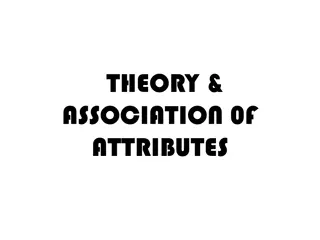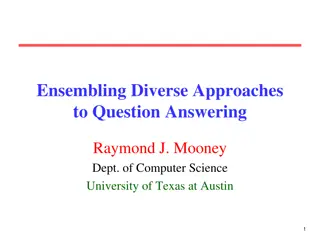Attributes of Good Question Design in Test Papers
The presentation discusses the essential attributes of designing good test questions, focusing on clarity, reliability, validity, authenticity, and fairness. It emphasizes the importance of clear instructions, precise terminology, and unbiased evaluation criteria in creating effective assessment tools. The content also highlights the significance of ensuring consistency in grading, allowing for discrimination between varying levels of performance, and aligning questions with learning outcomes. Different question formats, such as short answer and essay-type questions, are explored to assess knowledge breadth and depth effectively. Moreover, authenticity in question setting is emphasized to mirror real-world practice scenarios.
Download Presentation

Please find below an Image/Link to download the presentation.
The content on the website is provided AS IS for your information and personal use only. It may not be sold, licensed, or shared on other websites without obtaining consent from the author. Download presentation by click this link. If you encounter any issues during the download, it is possible that the publisher has removed the file from their server.
E N D
Presentation Transcript
Setting of Question Paper Dr. Shrish Bhatnagar
Objective of presentation Physical Assembling Blue Print Appropriate marking scheme Attributes of Good Test Detailed Question wise analysis
Attributes of good question design Clarity Reliability Validity Authenticity Fairness
Attributes of good question design Clarity Reliability Validity Authenticity Fairness Nothing in the content or structure of [a test] item should prevent an informed student from responding correctly. Gronlund (1998) Think about points such as: unclear test instructions, confusing and ambiguous terminology, being overly verbose, using complicated vocabulary, difficult or poor sentence structure, unnecessary and distracting detail.
Clarity Version B Second World War ? Compare the advances in UK public health policy pre- and post-
Attributes of good question design Clarity Reliability Validity Authenticity Fairness Does the question allow markers to grade it consistently and reproducibly and does it allow markers to discriminate between different levels of performance? Depends on the quality of the marking guidance and clarity of the assessment criteria. Can be improved through training and opportunities to learn from more experienced assessors. The likelihood of eliciting an accurate measure of a student s ability will be increased when students are provided with a variety of ways to demonstrate their knowledge and skills . i.e Triangulate Question Formats
Attributes of good question design Clarity Reliability Validity Authenticity Fairness A valid examination question measures achievement of the intended learning outcomes of the module/unit module (not just what is easy to measure!). The form of the examination question may also be of importance in ensuring validity. For example ....Short Vs Essay Type Question Short Answers : Good way of assessing greater breadth of material covered in a course and tend to focus on testing attainment and application of knowledge. Essay style questions: Allow a more in depth exploration of subject material and require a candidate to build and structure an argument.
Attributes of good question design Clarity Reliability Validity Authenticity Fairness Authenticity is the need to match the style and approach of question setting to the reality of practice This may be very important when considering the testing of procedural knowledge or functioning knowledge For Example : Write IAP Schedule of Immunization for child till 9 months of age Variations : what vaccination schedule would you follow if child comes for vaccination for the first time at 5 months
Attributes of good question design Clarity Reliability Validity Authenticity Fairness You need to give students a fair chance to demonstrate what they know and can do and to be able to succeed in examinations. Fairness can be facilitated by : Being very clear about expectations in student performance, Providing examples of past examination papers, Opportunities for students to practice and gain Mock Exams transparency in the processes to mark and grade their work.
Constructive Alignment Term by John Biggs
What kinds of knowledge and skills can be tested in examinations Exam questions should test a range of knowledge and skills at Masters level. They should test and reward critical appreciation and the ability to apply what has been learnt rather than the passive reproduction of memorised facts.
Intellectual Skills Students need to show they are able to interpret the meaning of data and evaluate their significance. Bloom et al (1956) identified three different domains of learning, Cognitive (knowledge), Affective (attitudinal) and Psychomotor (manual skills).
Take a few moments to look down this list of question stems and select two that you feel could be used to test students. Why have you selected these two?
Reducing the impact of extraneous factors such as stress, interpretation, time Attempts should be made to reduce the impact that stress and nerves may have on a student s performance in an examination. Open book exams or question topics pre-seen by candidates. If examinations are to be run traditionally try : Provide any important (untested) background detail within the body of the question; Give mark or timing guides within the framing of the question that indicate the relative importance for each sub-section; Set multiple-part problem questions so that the parts are independent from each other. This means that if a student gets the first part wrong they don t automatically lose marks in subsequent sections
Objective of presentation Physical Assembling Blue Print Appropriate marking scheme Attributes of Good Test Detailed Question wise analysis
Objective of presentation Physical Assembling Blue Print Appropriate marking scheme Attributes of Good Test Detailed Question wise analysis
Appropriate marking scheme Assessment criteria describe the extent to which students have achieved the specified learning outcomes. Two Different Approaches to Marking Assigning grades fairly and robustly is a demanding occupation for all teachers and we employ a range of approaches to help us to do this reliably and consistently. Two very different methods are often used simultaneously and symbiotically norm referencing and criteria referencing.
Norm Referencing Norm referencing is all about comparison Ultimate form of norm-referenced assessment is when we attempt to fit our marking profile for a cohort of students to the bell-shaped curve This pattern of achievement anticipates that a few students will fail and a similarly few students will get distinctions whilst the majority will gain marks that cluster and peak in the middle mark range.
Criterion referenced grading Specifies a standard through the description of clear criteria and anybody who achieves the level or standard described gains the marks so everybody in the cohort could potentially get an A
Value of good marking guidelines Help identify problems with assignments. Confirm different types of possible responses to the assignment question(s) and what knowledge and/or skills are being tested. Establish the necessary content for achieving different level marks Encourage consistency between marking team members. Provide ideas and wording for constructive feedback to students regarding what would have constituted a good or better response.
Providing support and guidance for students Strategies to support students are usually based upon two guiding principles; a) Transparency students knowing how and when their learning achievements are going to be judged and evaluated from the outset of their studies; b) Providing opportunities to practice and rehearse the ways in which they will be required to demonstrate their learning achievements. It may be helpful to keep in mind that ultimately learning is a transformative process, personal to the individual, that isn t confined by or restricted to set points of assessment.
Security issues It is important to be aware of information security matters when handling exam questions. Please follow the procedures set for your course carefully. E.g.: Have password protect files, Place in electronic but secure tutor area Hand-deliver rather than send in unsealed envelopes or at least seal and mark as confidential to the named recipient, Be careful not to leave any documents related to question paper loosely
Concluding Remarks Start early the process of innovating, drafting, gaining feedback, re-drafting etc takes time 1 Questions should be discrete sub-sections and are accompanied by their associated marking schedules 2 Keep sentences short, layout clear and well spaced out and use precise and unambiguous language. 3 Marking guidance ensure consistency it could be a model/specimen answer or a list of elements that should or could be included in an answer 4



